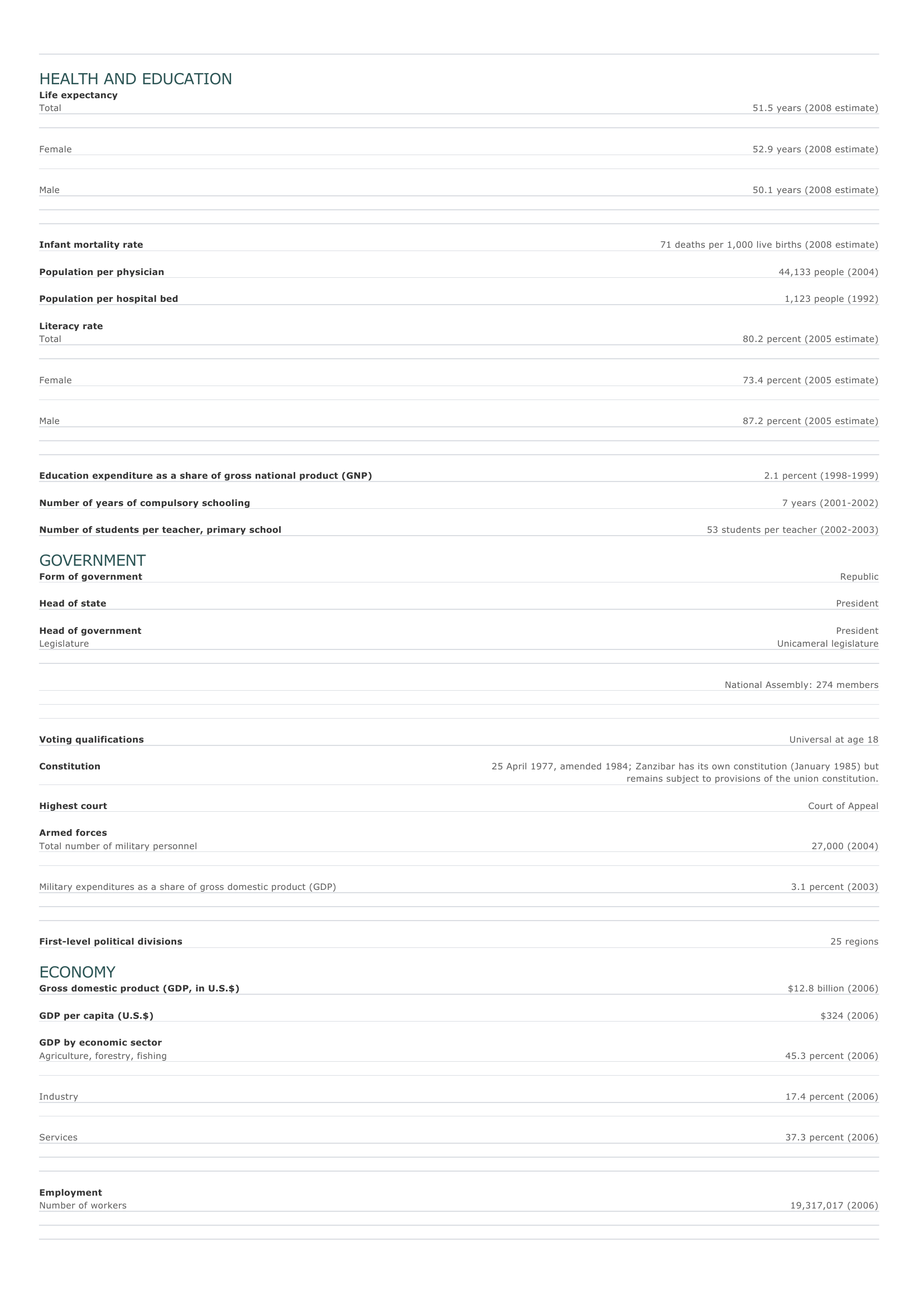Tanzania Facts and Figures. BASIC FACTS Official name United Republic of Tanzania Capital Dar es Salaam (current) Dodoma (designate) Area 945,100 sq km 364,900 sq mi PEOPLE Population 40,213,162 (2008 estimate) Population growth Population growth rate 2.07 percent (2008 estimate) Projected population in 2025 53,427,873 (2025 estimate) Projected population in 2050 66,843,312 (2050 estimate) Population density 45 persons per sq km (2008 estimate) 118 persons per sq mi (2008 estimate) Urban/rural distribution Share urban 38 percent (2005 estimate) Share rural 62 percent (2005 estimate) Largest cities, with population Dar es Salaam 2,497,940 (2002) M wanza 233,013 (1988) Dodoma 155,000 (2003 estimate) Tanga 187,634 (1988) Zanzibar 157,634 (1988) Ethnic groups Sukuma, Nyamwezi, Haya, Ngonde, Chagga, Gogo, Ha, Hehe, Nyakyusa, Nyika, Ngoni, Yao, Masai, Arab, Indian, Pakistani, European, many others Languages Swahili (official), English (official; used for commerce, administration, and higher education) NOTE: The first language of most people is that of their culture group. Religious affiliations Mainland: Christian 45 percent Muslim 35 percent Hindu, indigenous beliefs, and other 20 percent Zanzibar: Muslim O ther 99 percent 1 percent HEALTH AND EDUCATION Life expectancy Total 51.5 years (2008 estimate) Female 52.9 years (2008 estimate) Male 50.1 years (2008 estimate) Infant mortality rate Population per physician Population per hospital bed 71 deaths per 1,000 live births (2008 estimate) 44,133 people (2004) 1,123 people (1992) Literacy rate Total 80.2 percent (2005 estimate) Female 73.4 percent (2005 estimate) Male 87.2 percent (2005 estimate) Education expenditure as a share of gross national product (GNP) Number of years of compulsory schooling Number of students per teacher, primary school 2.1 percent (1998-1999) 7 years (2001-2002) 53 students per teacher (2002-2003) GOVERNMENT Form of government Head of state Head of government Legislature Republic President President Unicameral legislature National Assembly: 274 members Voting qualifications Constitution Highest court Universal at age 18 25 April 1977, amended 1984; Zanzibar has its own constitution (January 1985) but remains subject to provisions of the union constitution. Court of Appeal Armed forces Total number of military personnel Military expenditures as a share of gross domestic product (GDP) First-level political divisions 27,000 (2004) 3.1 percent (2003) 25 regions ECONOMY Gross domestic product (GDP, in U.S.$) GDP per capita (U.S.$) $12.8 billion (2006) $324 (2006) GDP by economic sector Agriculture, forestry, fishing 45.3 percent (2006) I ndustry 17.4 percent (2006) Services 37.3 percent (2006) Employment Number of workers 19,317,017 (2006) Workforce share of economic sector Agriculture, forestry, fishing 82 percent (2001) I ndustry 3 percent (2001) Services 15 percent (2001) Unemployment rate 5.1 percent (2001) National budget (U.S.$) Total revenue $733 million (1996 estimate) Total expenditure $768 million (1996 estimate) Monetary unit 1 Tanzanian shiling (TSh), consisting of 100 cents Major trade partners for exports United Kingdom, France, India, Japan, and Netherlands Major trade partners for imports South Africa, Japan, Australia, United Kingdom, and United Arab Emirates ENERGY, COMMUNICATIONS, AND TRANSPORTATION Electricity production Electricity from thermal sources Electricity from hydroelectric sources 8.95 percent (2003 estimate) 91.05 percent (2003 estimate) Electricity from nuclear sources 0 percent (2003 estimate) Electricity from geothermal, solar, and wind sources 0 percent (2003 estimate) Number of radios per 1,000 people 280 (1997) Number of telephones per 1,000 people 4 (2004) Number of televisions per 1,000 people 22 (2000 estimate) Number of Internet hosts per 10,000 people Daily newspaper circulation per 1,000 people Number of motor vehicles per 1,000 people Paved road as a share of total roads 1.6 (2003) 4 (1996) 4.6 (1997) 9 percent (2003) SOURCES Basic Facts and People sections Area data are from the statistical bureaus of individual countries. Population, population growth rate, and population projections are from the United States Census Bureau, International Programs Center, International Data Base (IDB) (www.census.gov). Urban and rural population data are from the Food and Agriculture Organization (FAO) of the United Nations (UN), FAOSTAT database (www.fao.org). Largest cities population data and political divisions data are from the statistical bureaus of individual countries. Ethnic divisions and religion data are largely from the latest Central Intelligence Agency (CIA) World Factbook and from various country censuses and reports. Language data are largely from the Ethnologue, Languages of the World, Summer Institute of Linguistics International (www.sil.org). Health and Education section Life expectancy and infant mortality data are from the United States Census Bureau, International Programs Center, International database (IDB) (www.census.gov). Population per physician and population per hospital bed data are from the World Health Organization (WHO) (www.who.int). Education data are from the United Nations Educational, Scientific and Cultural Organization (UNESCO) database (www.unesco.org). Government section Government, independence, legislature, constitution, highest court, and voting qualifications data are largely from various government Web sites, the latest Europa World Yearbook, and the latest Central Intelligence Agency (CIA) World Factbook. The armed forces data is from Military Balance. Economy section Gross domestic product (GDP), GDP per capita, GDP by economic sectors, employment, and national budget data are from the World Bank database (www.worldbank.org). Monetary unit, agriculture, mining, manufacturing, exports, imports, and major trade partner information is from the statistical bureaus of individual countries, latest Europa World Yearbook, and various United Nations and International Monetary Fund (IMF) publications. Energy, Communication, and Transportation section Electricity information is from the Energy Information Administration (EIA) database (www.eia.doe.gov). Radio, telephone, television, and newspaper information is from the United Nations Educational, Scientific and Cultural Organization (UNESCO) database (www.unesco.org). Internet hosts, motor vehicles, and road data are from the World Bank database (www.worldbank.org). Note Figures may not total 100 percent due to rounding. Microsoft ® Encarta ® 2009. © 1993-2008 Microsoft Corporation. All rights reserved.



